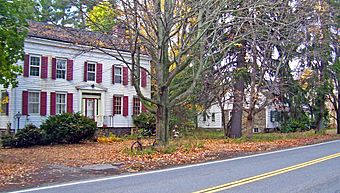Main Street Historic District (Stone Ridge, New York) facts for kids
Quick facts for kids |
|
|
Main Street Historic District
|
|

Houses amidst wooded lots along Main Street, 2007
|
|
| Location | Stone Ridge, NY |
|---|---|
| Nearest city | Kingston |
| Area | 70 acres (28 ha) |
| Built | 1750-1930 |
| Architectural style | Colonial, Federal style, Greek Revival, Craftsman |
| NRHP reference No. | 88000666 |
| Added to NRHP | 1988 |
The Main Street Historic District is a special area in Stone Ridge, New York. It's found along a main road called US 209 and NY 213. This district is part of the Town of Marbletown in Ulster County. It stretches from the south end of the community to just north of Cooper Street.
This historic district covers about 70 acres (28 hectares). It includes 97 different buildings and features on 38 separate pieces of land. Almost all of these, 92 out of 97, help make the district special and historic. In 1988, the Main Street Historic District was officially added to the National Register of Historic Places. This means it's recognized as an important place in American history.
Contents
What Makes Main Street Special?
Most of the buildings in the Main Street Historic District are houses. They were built a long time ago, mostly in the 1700s and early 1800s. Some of the oldest houses are made of stone. For example, the Hasbrouck House is at the very south end of the district. Another famous one is the Cornelius Wynkoop Stone House, built in 1767. It's said that George Washington himself once slept there!
A Walk Through Architectural Styles
As you walk along Main Street, you'll see different building styles. Some houses show the Federal style, which was popular after the American Revolution. Others are in the Greek Revival style, which looks like ancient Greek temples. Good examples include the Tack Tavern, the Marbletown Dutch Reformed Church, and the town library. The library building used to be the home of Edward Lounsbery.
You might also spot a few houses built in the Craftsman or Victorian styles. These are mixed in with the older homes. The entire street has stayed pretty much the same since the early 1900s. The only big new building is Marbletown's town hall and its garages.
Famous Visitors and Old Trees
The Wynkoop House is especially famous. It was added to the National Register of Historic Places on its own in 1996. Six black locust trees stand in front of this house. They were planted around the time the house was built, more than 250 years ago! These trees are also considered an important part of the house's history.
The Lay of the Land
From the very beginning, when people first settled here, buildings were built close to what was then called the Old Mine Road. There aren't many side streets in the district. This is because the land on both sides of the road slopes down into wetlands, which are areas too wet to build on.
Even though the houses are built close to the road, their properties are actually quite large. They range from small quarter-acre lots to huge ones over twenty acres! Many houses also have old outbuildings, like barns or sheds, behind them. These are often hidden from the road by the many trees. The trees also help make the area feel like a mix of country and town as you drive into Stone Ridge.




